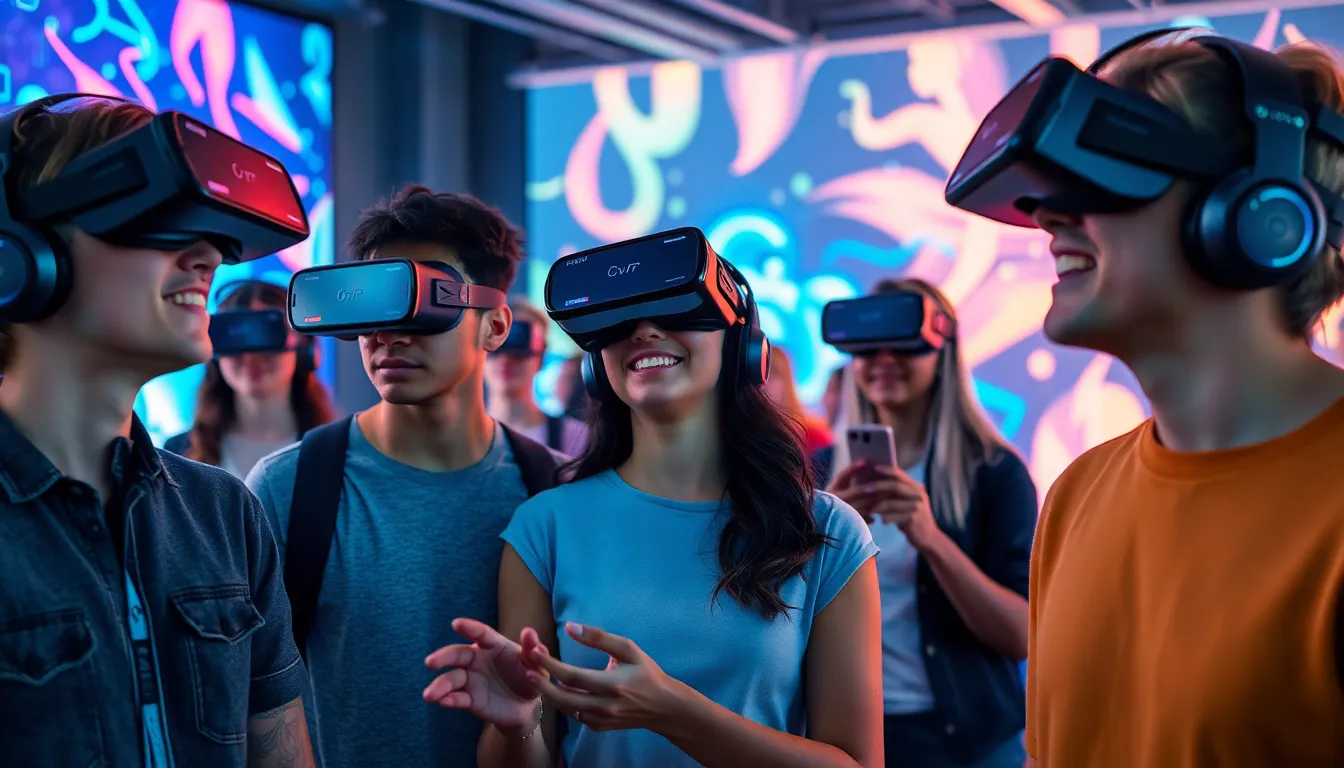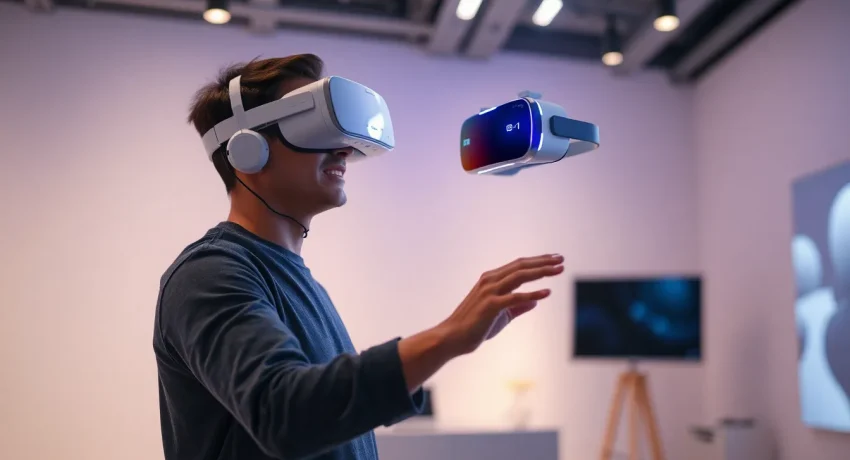Table of Contents
ToggleThe intersection of artificial intelligence and virtual reality is transforming how people experience digital environments. AI-driven VR is not just a buzzword; it’s a revolutionary approach that enhances immersion, interactivity, and personalization. By leveraging AI algorithms, VR systems can adapt to users’ actions and preferences, creating a more tailored and engaging experience.
As industries from gaming to education embrace this technology, the possibilities seem endless. Imagine a virtual classroom where AI analyzes each student’s learning style, or a gaming experience that adjusts difficulty in real-time based on player performance. This synergy of AI and VR is reshaping not only entertainment but also training, therapy, and social interaction. Understanding its implications is crucial for anyone interested in the future of technology.
Overview of AI-Driven VR
AI-driven VR combines artificial intelligence with virtual reality, creating immersive and interactive digital environments. This technology adapts to user behaviors and preferences, enhancing the overall experience.
Key Features
- Adaptive Learning: AI analyzes user interactions, personalizing learning experiences in educational settings. For example, it can modify content delivery to match individual learning styles.
- Real-Time Adjustments: In gaming, AI alters difficulty levels based on player performance, ensuring a suitable challenge and engagement.
- Enhanced Immersion: AI improves realism in virtual environments by simulating human-like responses and behaviors, making interactions feel authentic.
- Personalization: AI creates customized content. Users receive unique experiences based on their preferences, increasing satisfaction and retention.
Applications Across Industries
AI-driven VR finds applications in various sectors:
- Education: Environments that adapt lessons based on learner engagement improve educational outcomes.
- Healthcare: Virtual simulations help in therapy and training, allowing practitioners to practice skills in safe settings.
- Entertainment: AI-generated narratives can respond to user choices, creating dynamic storytelling experiences.
- Workplace Training: Realistic scenarios assist employees in honing skills through immersive simulations, increasing preparedness.
Future Implications
AI-driven VR continues evolving, promising advancements across fields. Enhanced capabilities will shape how users interact with technology, fostering new methods of communication and learning. Industries that integrate this technology stand to benefit significantly from increased efficiency and engagement.
Key Features of AI-Driven VR

AI-driven VR incorporates advanced technologies to enhance user experiences through intelligent systems. The following key features exemplify its capabilities.
Adaptive Environments
AI-driven VR creates adaptive environments that respond dynamically to user actions. Systems analyze user behavior and preferences in real-time, allowing virtual spaces to modify aspects such as lighting, design, and complexity. For example, in educational settings, software can adjust scenarios based on a student’s learning pace. In gaming, virtual worlds modify challenges to match player skills, ensuring engagement without overwhelming users.
Enhanced User Interaction
Enhanced user interaction represents another critical aspect of AI-driven VR. Natural language processing and machine learning enable more intuitive communication between users and virtual characters or environments. Users can engage with AI avatars that understand contextual cues and respond appropriately, fostering deeper emotional connections. These interactions elevate experiences in therapy, where clients can practice social skills through realistic simulations. In gaming, players can collaborate with AI companions, creating a more immersive and lifelike experience.
Applications of AI-Driven VR
AI-driven VR integrates smart technologies into various sectors, providing unique, personalized experiences. Key applications include gaming, education, and healthcare, each demonstrating how AI enhances engagement and interaction.
Gaming and Entertainment
AI-driven VR elevates gaming experiences through adaptive storytelling, where narratives shift according to player choices. Real-time difficulty adjustments ensure players encounter suitable challenges, enhancing enjoyment. Interactive game environments utilize AI to create responsive worlds that react to player actions, fostering deeper immersion. Personalized content recommendations based on player behavior make the entertainment experience more engaging, ensuring that users encounter tailored elements that resonate with their preferences.
Education and Training
AI-driven VR transforms education by providing immersive learning experiences that adapt to individual learning styles. Smart educational tools assess student performance and modify content in real-time, ensuring effective knowledge retention. Simulations allow students to practice real-world scenarios in a controlled environment, improving skills without real-life consequences. Companies and institutions also leverage AI-driven VR for employee training, using specific virtual scenarios that enhance skill acquisition and retention, resulting in a more competent workforce.
Healthcare and Therapy
AI-driven VR offers significant benefits in healthcare, especially in therapeutic and rehabilitative contexts. Tailored simulations create safe spaces for patients to confront fears or practice social skills, enhancing treatment outcomes. Medical training programs utilize AI-driven VR to immerse healthcare professionals in realistic scenarios, allowing for hands-on experience without risk. This technology not only aids in teaching but also in patient evaluations, where AI analyzes responses and adjusts approaches accordingly, leading to more personalized care strategies.
Challenges and Limitations
AI-driven VR faces significant challenges and limitations that affect its widespread adoption and efficacy.
Technical Barriers
Technical barriers hinder the integration of AI and VR technologies. High computational demands often lead to performance issues, including latency and reduced frame rates, which can detract from user immersion. Hardware limitations, such as insufficient processing power or subpar graphics capabilities, restrict the complexity of virtual environments. Additionally, the need for advanced algorithms in machine learning requires continuous updates and maintenance, leading to increased development costs. Data privacy concerns also pose technical challenges, as collecting and processing user data necessitates stringent security measures to prevent breaches.
Ethical Considerations
Ethical considerations play a critical role in the deployment of AI-driven VR. The potential for user manipulation raises concerns about informed consent in virtual experiences. Ensuring that users understand how their data is used is essential, particularly in therapeutic and educational contexts. Moreover, AI algorithms might inadvertently perpetuate biases by reflecting existing societal prejudices, leading to unequal user experiences. The immersive nature of VR also presents risks related to addiction or desensitization, as individuals may prefer virtual interactions over real-life engagements. Addressing these ethical dilemmas is vital to fostering trust and ensuring responsible use of AI-driven VR technologies.
Future Trends in AI-Driven VR
AI-driven VR is poised for significant advancements, impacting various sectors. Innovations are expected to enhance immersion and personalization, providing users with unparalleled experiences.
- Intelligent Content Generation: AI algorithms will create dynamic content tailored to user preferences, enhancing storytelling in gaming and educational scenarios. Systems may adapt narratives based on individual choices, creating unique experiences for each participant.
- Enhanced Natural Interactions: Improvements in natural language processing will enable conversations with virtual characters that feel more human-like. Users can interact seamlessly, making experiences more engaging and realistic.
- Cross-Platform Integration: Future AI-driven VR applications will likely allow seamless access across devices, including smartphones, tablets, and VR headsets. This will enable continuity of experience, allowing users to transition effortlessly from one platform to another.
- Data-Driven Personalization: AI can analyze user behavior patterns to customize environments in real-time. For example, in educational settings, learning materials can adjust based on individual progress, fostering a more effective learning journey.
- Ethical AI Implementations: As awareness of data privacy and algorithmic bias grows, developers will prioritize ethical AI practices. Ensuring transparency and fairness in AI-driven VR applications is essential for gaining user trust.
- Advanced Analytics for Improvement: Implementation of analytics tools will track user interactions, providing feedback for ongoing development. This will enhance user experience by refining content and environments based on real data.
- Integrative Therapeutic Practices: Healthcare applications will increasingly incorporate AI-driven VR for therapy and rehabilitation. This integration will allow customization of therapeutic environments to more effectively address individual patient needs.
- Collaborative Experiences: Future VR platforms may offer more robust collaborative features. Users can engage in social experiences with AI companions or other users, creating a shared environment that enhances interaction.
AI-driven VR is set to redefine user engagement, with trends focusing on personalization, ethical practices, and collaboration. These developments project a future where technology fosters deeper connections and improved outcomes across various sectors.
AI-driven VR is revolutionizing how individuals interact with digital environments. By enhancing immersion and personalization, it creates experiences that are not only engaging but also tailored to individual needs. As this technology evolves, it promises to reshape industries like education, healthcare, and entertainment, making interactions more intuitive and meaningful.
Addressing the challenges and ethical concerns surrounding AI-driven VR is crucial for its responsible implementation. The future holds exciting possibilities, with intelligent content generation and collaborative experiences on the horizon. Ultimately, AI-driven VR is poised to foster deeper connections and improve outcomes, paving the way for a more interactive and personalized digital landscape.




